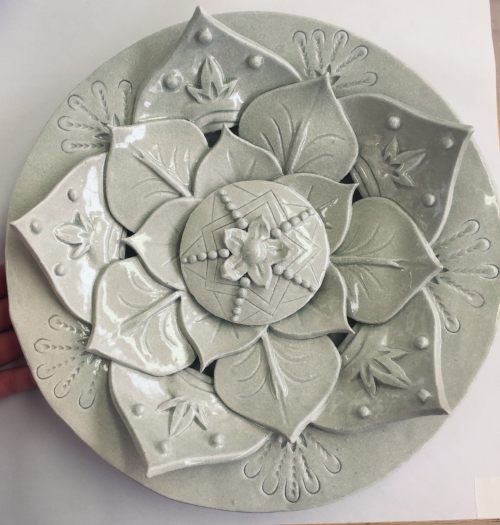In the last two years studying conservation at West Dean College, I have learned the ins and outs of the ways ceramic objects degrade and break. Along with learning how to repair these breakages, I am now able to more accurately identify areas of stress or weakness inherent in the object. These observations have impacted the way I make ceramics. It makes me more aware and careful of weak spots.
Last year, I undertook the making of a large stoneware sculptural plate. It has layers of curved petals and a central circle that is set above the center of the plate. This was never meant to be a functional object, so there was never any need to account for wear-and-tear, however, I took my conservation training into account while constructing the piece. This mindset was new for me; these ideas had never occurred to me in over a decade of making pottery and ceramics.
My training first came into play when making this plate with my selection of a clay body. I knew that for a decorative piece, any clay body would be acceptable. But, through my studies, I now know that stoneware was the best selection to ensure its structural strength. Stoneware, being a high fire, low porosity, partially vitrified clay body, has much more tensile strength than lower fired clay bodies.
As I was planning the construction of the sculptural parts, I had originally considered the possibility of carving all the petals out of a single large block of clay and then mounting that piece onto the base of the plate. This would have been easier in the short term, but after reflection, I came to the conclusion that carving out the thinnest bits would cause inherent weaknesses that could lead to cracking and firing cracks, even in stoneware. Thus, I decided to construct the plate piecewise. I first made a template for each layer of petals, carved and detailed each individual petal, and then finally arranged them on the plate’s base.
Once all the components were complete, I did a “dry-run” of the final layout.
When it came time to join all the separate parts onto the base, I again had to pause and consider my options. Through my conservation training, I knew that the joins were the areas most likely to break. This presented an issue for my plate, as the curve of the petals did not line up tightly with the curve of the plate. I feared (much more than I ever had during construction of an object) that these areas would simply not hold through the firing. This insecurity made me nearly neurotic with scoring and slipping (the normal process used to join pieces of wet clay together) as I set the petals into the base. In the end, I also added many more supports than were strictly necessary, knowing that this would only add to the strength of the piece, as well as making any future repairs easier because there is extra surface area to work with.
In the end, the plate made it through the firing and glazing process without an issue. It even made it all the way to Texas packed in a box. However, until I began making this object with the training I have now, I never put much thought into the longevity of my pieces. Conservation training has undoubtedly changed the way I think when making ceramics.
The final product.



